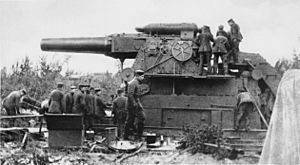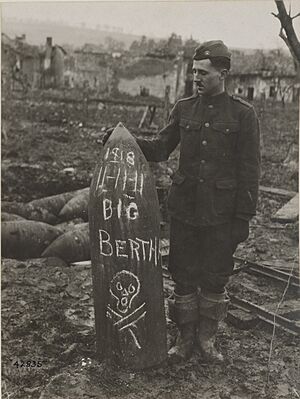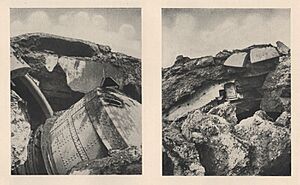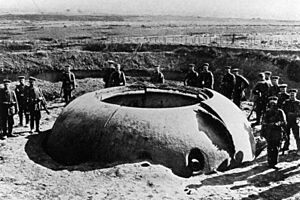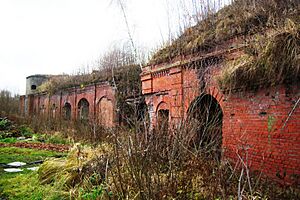Big Bertha facts for kids
Quick facts for kids 42 centimetre M-Gerät "Big Bertha" |
|
|---|---|
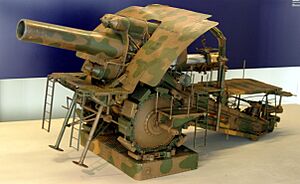
Model of an M-Gerät at the Musée de l'Armée
|
|
| Type | Siege artillery |
| Place of origin | |
| Service history | |
| In service | 1914–1918 |
| Used by | Imperial German Army |
| Wars | World War I |
| Production history | |
| Manufacturer | Krupp |
| Variants | 30.5 centimetre Beta-M-Gerät |
| Specifications | |
| Mass | 42,600 kg (93,900 lb) |
| Length | 10 m (33 ft) |
| Barrel length | 5.04 m (16 ft 6 in) L/12 |
| Width | 4.7 m (15 ft) |
| Height | 4.5 m (15 ft) |
| Diameter | 42 cm (17 in) |
|
|
|
| Caliber | 420 mm (17 in) |
| Elevation | +65° |
| Traverse | 360° |
| Rate of fire | 8 shells an hour or 1 shell per 7.5 minutes |
| Muzzle velocity | 400 m/s (1,300 ft/s) |
| Maximum firing range | 9,300 m (30,500 ft) |
The 42 centimetre kurze Marinekanone 14 L/12 (short naval cannon), often called the Minenwerfer-Gerät (M-Gerät), was a huge German cannon. People knew it best by its nickname, Big Bertha.
This powerful gun was built by a company called Krupp AG in Essen, Germany. The Imperial German Army used it from 1914 to 1918 during World War I. The M-Gerät had a barrel that was 42 cm (17 in) wide. This made it one of the biggest artillery pieces ever used in battle.
The M-Gerät was designed in 1911. Its goal was to break through the strong modern forts in France and Belgium. Production started in 1912. Testing began in early 1914. When World War I started, two prototype M-Gerät guns were sent to Liège, Belgium. They quickly destroyed Forts Pontisse and Loncin. German soldiers gave the gun the nickname "Big Bertha." This name then spread to newspapers and to the Allies. They used it for all large German cannons.
Later in the war, a smaller gun was made. It was 30.5 cm (12.0 in) and called the Beta-M-Gerät. This was because the original Big Bertha guns were sometimes damaged by their own faulty ammunition. The Beta-M-Gerät was used from 1916 until the end of the war. It had a longer barrel but was not as effective as the original Big Bertha.
Contents
Building a Giant Gun
Why Germany Needed Big Cannons
In the 1850s, artillery technology got much better. This led to a race between cannons and fortresses. New rifled cannons could shoot farther than fortress guns. So, countries started building rings of forts around cities. These forts were made of concrete and had guns in armored, rotating casemates. France built a huge fortified zone on its border with Germany. Belgium also built its own strong forts.
Germany wanted to be able to break through these strong forts. Their most powerful gun, a 21 cm (8.3 in) howitzer, was not strong enough. So, in the 1880s, Germany started asking for more powerful guns. This became very important for Germany's war plans. They planned to quickly defeat France by going through Belgium. To do this, they needed cannons that could destroy French and Belgian forts.
Early Attempts at Super Guns
In 1893, Germany's Artillery Test Commission (APK) teamed up with Krupp AG. Their first big gun was a 30.5 cm (12.0 in) mortar. It was called the Beta-Gerät. This name was used to hide its real purpose as a siege gun. Tests showed that even this gun could not destroy the strong French or Belgian forts.
Interest in a stronger siege gun grew after the Russo-Japanese War. During that war, Japan used large 28 cm (11 in) coastal guns to break through forts.
In 1906, Germany decided to make an even more powerful gun. They looked at a gun as big as 45 centimetres (18 in). But they chose a 30.5 cm (12.0 in) howitzer and a 42 cm (17 in) gun. The Gamma-Gerät was designed and tested from 1906 to 1911. It was very powerful and could shoot farther than fort guns. But it was too heavy and slow to move. It needed rail lines and took 24 hours to set up.
Designing the Big Bertha
Krupp started working on a siege gun that could be moved by road. After trying different sizes, they finally developed the wheeled 42 cm (17 in) howitzer in late 1911. This was the 42-centimetre kurze Marinekanone 14 L/12, or Minenwerfer-Gerät (M-Gerät).
Germany ordered its first M-Gerät in July 1912. Tests in December 1913 showed that gas-powered tractors were best for pulling it. Firing tests began in February 1914. Even Kaiser Wilhelm II watched one of these tests. Krupp thought the M-Gerät would be ready by October 1914.
How Big Bertha Was Built
When put together, the M-Gerät weighed 42.6 t (47.0 tons). It was 4.5 m (15 ft) tall, 10 m (33 ft) long, and 4.7 m (15 ft) wide. It sat on a steel base. The gun could turn all the way around (360°).
The gun was loaded from the back. It had a 5.04 m (16.5 ft) barrel that could be lifted up to 65 degrees. The M-Gerät could shoot shells up to 9,300 m (30,500 ft) away. Krupp eventually built 12 M-Gerät howitzers.
To move Big Bertha, it had to be taken apart. It was carried in five large wagons. Each wagon weighed between 16 to 20 t (16 to 20 long tons; 18 to 22 short tons). Special gas-powered tractors pulled these wagons. Horses could not pull them because they were too heavy. The wagons had special "articulated feet" called radgürteln. These helped them move across rough ground. In good conditions, the tractors could move at 7 km/h (4.3 mph).
The Beta-M-Gerät
The 30.5 cm (12.0 in) Beta-M-Gerät was made in late 1917. It was meant to replace Big Bertha guns that had broken down. It had a longer, 9 m (30 ft)-long naval barrel. This barrel was put onto Big Bertha's base. The Beta-M-Gerät weighed 47 t (46 long tons; 52 short tons) and could shoot up to 20,500 m (67,300 ft). However, the powerful propellant used caused three of the four Beta-M-Gerät guns to explode. This meant their range had to be limited, which defeated the purpose of the longer barrel. Only four Beta-M-Gerät guns were made.
| Name | Calibre | Weight | Range | Rate of fire | Time to emplace (hours) |
|---|---|---|---|---|---|
| M-Gerät "Big Bertha" | 42 cm (17 in) | 42.6 t (41.9 long tons; 47.0 short tons) | 9,300 m (30,500 ft) | 8 shells an hour | 5–6 |
| Gamma-Gerät | 150 t (150 long tons; 170 short tons) | 14,000 m (46,000 ft) | 24 | ||
| Beta-M-Gerät | 30.5 cm (12.0 in) | 47 t (46 long tons; 52 short tons) | 20,500 m (67,300 ft) | 7–8 | |
| Beta-Gerät 09 | 45 t (44 long tons; 50 short tons) | 12,000 m (39,000 ft) | 12 shells an hour | 12 | |
| Beta-Gerät | 30 t (30 long tons; 33 short tons) | 8,200 m (26,900 ft) | 15 shells an hour |
Ammunition for Big Bertha
Big Bertha used three types of shells. There were armor-piercing shells, which broke through concrete and metal. There were also high-explosive shells. These could be set to explode right away or after a delay. If delayed, they could go through up to 12 m (39 ft) of earth before exploding. The third type was a lighter "short shell." It had a special tip for better range and accuracy.
These shells were about 1.5 m (4 ft 11 in) long. They weighed between 400 and 1,160 kg (880 and 2,560 lb). They were pushed out of the gun by a primer in a brass casing. Sometimes, the shells had problems. Starting in 1916, some German siege guns had internal explosions because of bad ammunition. Because of this, gun crews had to stand far away and pull a lanyard to fire the gun.
Big Bertha in Action
Western Front Battles
In August 1914, two prototype Big Bertha guns were sent to the Western Front. Their first mission was to help capture Liège, Belgium. German troops entered Liège on August 7. But the city's forts were still firing. Big Bertha guns began attacking on August 12. They bombarded Fort de Pontisse, which surrendered after two days.
Next, Big Bertha moved to Fort de Loncin. This fort was defended by General Gérard Leman. On August 15, Big Bertha fired for two hours. Its 25th shot hit a magazine (where ammunition is stored). This caused a huge explosion that destroyed the fort. The last two forts in Liège surrendered the next day.
After Liège, Big Bertha moved to Namur, Belgium. The forts there were not well-prepared. On August 23, Big Bertha destroyed Fort de Marchovelette with a magazine explosion. It then helped force the surrender of Fort de Maizeret.
Big Bertha also helped in the Siege of Maubeuge in France. Bombardment began on August 30. By September 5, German guns had made a hole in the fortress ring. Big Bertha helped widen this gap. It destroyed Forts Leveau, Héronfontaine, and Cerfontaine on September 7. The city of Maubeuge was captured on September 8.
Later, Big Bertha was sent to Antwerp, Belgium. The Belgian army had retreated there. On September 30, Big Bertha started firing on the Fort de Lier. The fort was abandoned on October 2. Big Bertha then attacked and destroyed the Fort de Kessel and the Fort de Broechem. Antwerp surrendered on October 10.
In early 1916, many Big Bertha guns were sent to the Battle of Verdun. This battle started with a huge artillery bombardment. The 42-centimetre guns tried to destroy forts like Fort Vaux and Fort Douaumont. But these modern forts were too strong. They could not be broken by Big Bertha's shells. Also, some Big Bertha guns were destroyed by their own faulty ammunition during this battle.
In the last two years of the war, many Big Bertha guns were lost. They were replaced with smaller guns. The remaining Big Bertha guns mostly shelled field defenses. In November 1918, the last two Big Bertha howitzers were surrendered to the American Expeditionary Force.
Eastern Front Battles
Big Bertha guns were also used on the Eastern Front. In May 1915, they helped in the attack on Przemyśl, which the Russians had captured. Big Bertha bombarded forts X, Xa, XI, and XIa. The Germans captured these forts, and the Russians left Przemyśl.
From August 8, Big Bertha helped attack Kaunas Fortress. The forts there were old and easily destroyed. The city fell on August 18.
Big Bertha also took part in the siege of Novogeorgievsk. On August 13, Big Bertha attacked forts XIV, XV, and XVI. German soldiers stormed these forts while the artillery fired. The Russians left the outer forts on August 18. The Germans then captured Novogeorgievsk the next day. The last time Big Bertha guns were used on the Eastern Front was in October 1915, during the invasion of Serbia.
Big Bertha's Legacy
The nickname "Big Bertha" (Dicke Berta) came from German soldiers at the Battle of Liège. It was a reference to Bertha Krupp, who owned the Krupp company that made the guns. The name became popular and was used for all large German artillery.
Today, the name "Big Bertha" is still known. For example, it's used for a line of Callaway golf clubs.
Two Big Bertha guns were given to the US Army in November 1918. One was taken to the United States for study and display. Both were later taken apart in the 1940s and 1950s. A World War I veteran named Emil Cherubin built a replica of a Big Bertha. It traveled around Germany and even appeared on postage stamps.
The Paris Gun, a different type of large German gun used to bomb Paris in 1918, is sometimes confused with Big Bertha.
Images for kids
See also
 In Spanish: Gran Berta (desambiguación) para niños
In Spanish: Gran Berta (desambiguación) para niños
- List of the largest cannon by caliber
- German WW II Karl-Gerät SP mortar


